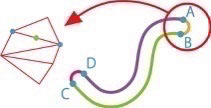“Dynamic Projection Mapping for Silkworms” by Arano and Morimoto
Conference:
Type(s):
Entry Number: 21
Title:
- Dynamic Projection Mapping for Silkworms
Presenter(s)/Author(s):
Abstract:
Recently, there has been an increasing number of examples of dynamic projection mapping (DPM) applied to plants and animals. However, objects such as animals and plants are deformable, and it is difficult to obtain their shape or attach markers in advance; thus, these objects present a problem for DPM. Here, we propose an automatic generation method of DPM specially designed for silkworms. In addition, the system automatically generates visual-effect animations based on the shape of the projected object. Using this system, we conducted an experiment of projection on a real silkworm.
Projections in the Forest [Schoor and Mawad 2014] is one example of a work in which PM is applied to plants and animals. In this previous work, static projection mapping was performed for plants and animals of the forest. Image registration for the mapping was performed manually by the artists, which required a substantial amount of time. For plant leaves with individual motion, a method of DPM that considers the occlusion of the projection area by the viewer has been proposed [Sueyoshi and Morimoto 2019]. This method automatically generates effects that match the shape of the plant. However, leaves exhibit small deformations, and it is difficult to obtain corresponding large deformations using this method. A method for applying DPM to human faces has also been proposed [Bermano et al. 2017]. This method can track the movement of a face without the need for markers. However, this method requires 3D face data with various expressions to be input in advance. Open- Pose [Cao et al. 2017], which uses deep learning to detect skeletal structures from an input image of a human obtained via a monocular camera, has been proposed. This approach is marker- less, requiring only the input image. However, the detection target is human-based, and non-human skeleton detection is not supported.










